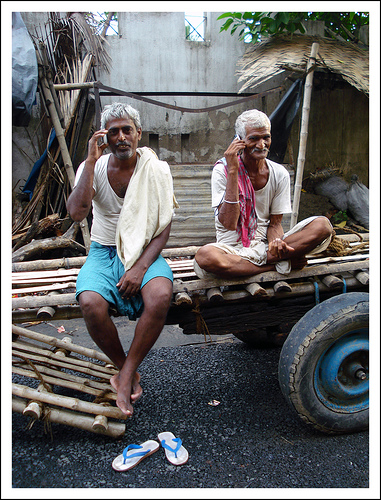Guest Post by Amrit Pal
Move over, adult entertainment
It might border on redundant to mention that the social web has surpassed pornography as the most popular activity on the Internet.
In the Indian context, the web has begun to move beyond a media genre that was no different in terms of interruption when compared to conventional media like television and radio.
As privacy and choice gained momentum, permission-based Internet activity has led to what we now describe as the social web.
Image: Dipanker Datta via Flickr, CC 2.0
“Liking” a page translated from a click to a tangible emotion with human repercussions.
“User engagement” is the buzzword just seeping its way through every CEO’s checklist.
In fact, heavy manufacturing is probably the only exception in sectors that have been compelled to adopt social as a medium to “be remarkable” in human terms to their followers.
Consequently, social media agencies have mushroomed, with their fair share of self-confessed SM consultants cashing in on the tide.
Pink panties and social media
In terms of pure social involvement and contagiousness, the campaign with the highest immediate recall value is the “Pink Chaddi” movement.
(“Chaddi” is the Hindi word for “underwear.”)
As a protest against a right-wing Hindu fundamentalist organization’s assaults on what it termed “uncivilized women visiting bars,” a tribe of people decided to courier pink underwear to the organization’s offices.
The reaction spread like a virus and, in no time, more than a million pair of thongs were received at their office.
All this via one bare-bones blog and a Facebook group. Nothing quite sums up the impact of the legendary “pink chaddi.”
Image: Gaurovonomics via Flickr, CC 2.0
Neither convinced nor converted
Despite campaigns such as the pink chaddi, the Indian psyche towards social media can be best termed as skeptical, at the moment.
Apprehensions of a social bubble, destined to eventually attain saturation, still linger.
The entry level barriers in the social media sector being excruciatingly low, freelancers in SM barely command trust, barring a few exceptions. While most firms, sooner or later, joined the bandwagon, cross-sectoral impact is yet to be seen in a major way.
Advertising giants like Saatchi and Saatchi are slowly making a foray into the industry. In my opinion, it will take another five years, at least, for Indian social media to mature to the benchmarks set by campaigns like the Pepsi Refresh Project.
Indian users still have a long road to tread, where individual icons impact the conscience far deeper than evangelism.
Where do we go from here?
With a measly Internet penetration of 52 million in a country of 1.2 billion, the expandability of the social web is only limited by imagination.
India’s watershed scheme, the UIDAI, seeks to provide every Indian with a unique, digitally-signed, biometric-authorized identity.
Imagine the impact of UIDAI coupled with an API platform!
There is an unexplored goldmine of web services, waiting to be served to the core of India’s demography.
India is the cradle of regional languages. With the number of dialects numbering over a thousand, these invite customized content delivery.
As the social web penetrates virgin markets, improvising on what is exclusively perceived as an urban commodity, the next big thing could well be the semi-urban populace.
The next big thing
The rollout of 3G services in the near future further bolsters the avenues. Taking cues from platforms like Ushahidi and Ayllu, similar social technologies could add tremendous value to social and economic inclusion.
That would truly epitomize the spirit of “being social.”
With such territories begging to be explored, apprehensions of the social web attaining saturation can be put to rest.
It will, however, be engrossing to watch the myriad approaches that will lead to the revolution that India is heading towards.
More movements, more impact, more happiness and, perhaps, more campaigns à la pink panties!
 Amrit Pal is an undergraduate engineering student at BITS Pilani in Goa, India. A staunch Seth Godin disciple, he is engaged with social enterprise development and its intersection with social web. When not building startups across various sectors, he loves bickering about typography and design. His ramblings that occasionally matter can be read here.
Amrit Pal is an undergraduate engineering student at BITS Pilani in Goa, India. A staunch Seth Godin disciple, he is engaged with social enterprise development and its intersection with social web. When not building startups across various sectors, he loves bickering about typography and design. His ramblings that occasionally matter can be read here.










[…] The Arab Spring or The Pink Chaddi movement are varying examples of this phenomenon (recommended reading: Clay Shirky’s The Cognitive […]
[…] The Arab Spring or The Pink Chaddi movement are varying examples of this phenomenon (recommended reading: Clay Shirky’s The Cognitive […]
I just love the “You might also like” plugin for helping me find this post. I missed it way back when… and find it very interesting indeed. I love, love, love learning about how social media is changing things overseas! Thanks for posting!
@CyberlandGal Isn’t it great? It’s LinkWithin, btw. Really easy to set up as well, and I like the way it pulls images so it’s not just a few links you’re looking at.
[…] The Twitter family has seen exponential growth in the last few months by relationships that transcend the virtual web. I recently started guest posting at WaxingUnlyrical, curated by Shonali Burke. [Oh, let me go ahead and show off that she's listed as the top-25 women in Social Media in the United States]Right from day one, working with her has been a lesson in curating a lucid team that derives cohesiveness from relationships. Personally, it’s been a stepping stone to appreciate the soul of social media, moving beyond mere statistics. Towards Shonali and the WUL team, love wouldn’t be an exaggeration. [My first post on WaxingUnlyrical talked about the pink chaddi movement and the future of social in India. Read it here.] […]
Things I find disgusting. Pig Males who repress women. Goes on everywhere not picking on India. But the revolution has been going on for awhile and will continue. The Pink Panties was awesome!
Goa! OMG I so want to go to a Goa Beach Dance Party! Sigh
Have you been to Goa, Howie? It. Is. Awesome.
Yea, I thought this was a really smart campaign, it will be interesting to see how SM picks up in India.
[…] Here is the original post: How Pink Panties Heralded India's Social Media Movement | Waxing … […]
[…] Read more here: How Pink Panties Heralded India's Social Media Movement | Waxing … […]
[…] here: How Pink Panties Heralded India's Social Media Movement | Waxing … Posted in Media, TV | Tagged choice-gained, Comentário, indian, Media, move-beyond, […]
[…] This post was mentioned on Twitter by Pink Fans. Pink Fans said: How Pink Panties Heralded India's Social Media Movement | Waxing … http://bit.ly/eEYCAS […]